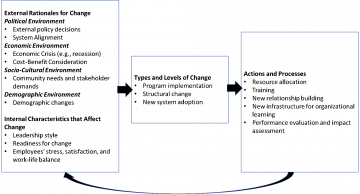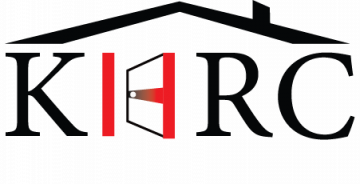In a recent publication, “Organizational Change in Human Service Organizations: A Review and Content Analysis”, KHRC researchers John Graham, Kyler Woodmass, Quinn Bailey, and Eric Li, with the assistance of Arielle Lomness, review the body of peer-reviewed work at the intersection of organizational change and human service organizations (including health services, human services, and social services) since 1968, in an effort to identify trends and present an overview of the discussed topics.
More specifically, our primary objectives were to:
- provide an approachable overview of this literature in a way that informs both practitioners and researchers on the breadth of topics and possible shifts over time
- support and guide future research at this intersection to build consensus and address potential gaps, as well as supporting future reviews
- provide a conceptual overview that can help introduce non-academic stakeholders to the topic, help orient any further research, and thereby also foster the uptake and implementation of evidence-based practice in HSOs generally
- provide a basic framework to help collaborative planning and bridge across diverse audiences, from theory to planning to implementation to evaluation
Practice Points
Our key observations related to organizational change in human service organisations include:
- Organizational changes should be understood as a dynamic process that can be influenced from impetus to intervention, by method of implementation and the nature of the organization in question
- There exists a wealth of frameworks, models, and theories relevant to HSOs, all with value in directing the development of processes and indicators (if one understands their goal)
- Regular synthesis of the ever-growing body of knowledge at the intersection of organizational change and HSOs supports up-to-date practice, commentary, and research inquiry
- Knowledge on organizational change should be approachable for diverse stakeholders to foster broad and shared understanding and help support consensus building from theorizing through implementation
- Our broad thematic overview can represent a starting point for directing interested audiences in subsequent, more targeted research to build evidence into their own unique context
Thematic Overview
Our thematic overview, shown below, pulls together the four key themes identified across this body of work into a dynamic interplay between each facet. The article makes the following comment:
“This visual representation of interplay between themes does not seek to be a comprehensive model of change, but rather a heuristic for observed understandings. As ‘organizational change’ in the context of HSOs – and beyond – is best understood as that dynamic process, support for change at the academic and policymaker levels alone may often be insufficient in materializing the change in question. There exist many contextual layers in understanding change dynamics, and any plan for successful implementation is likely to require holistic planning and intervention to support implementation proportionate to the scale and context of the change in question.”

Figure 6. Visual Representation of Interplay between Observed Themes.
Other Frameworks on Change in HSOs
The article overviews and discusses the specific intersection of change in this field, including a brief introduction into historical and conceptual contexts.
In addition, our search identified multiple articles by Packard and colleagues, seeking to: review the evidence base for HSOs (Packard & Shih, 2014); identify strategies used (via the Organizational Change Tactics Questionnaire; Packard et al., 2015); and compare findings to the broader literature on change (Packard et al., 2012). For further reading, note that Packard recently released a book at this intersection of topics: “Organizational Change for the Human Services”. It included both their own conceptual framework (p.41), as well as an approachable step-based overview of the elements within planned change models (p.40):
- Identify the problem, need, challenge, or opportunity
- Identify the desired future state: the change goal
- Assess the present: context, content, and process (external and internal factors)
- Determine an overall change strategy
- Communicate the need for and desirability of the change
- Create a sense of urgency
- Communicate the change vision
- Develop the action system
- Implement the change
- Develop and maintain support
- Institutionalize the change
- Evaluate the change

Figure 2.1 A conceptual framework for organizational change (p.41).
For more information, see:
- Packard, T. R. (2021). Organizational change for the human services. Oxford University Press.
